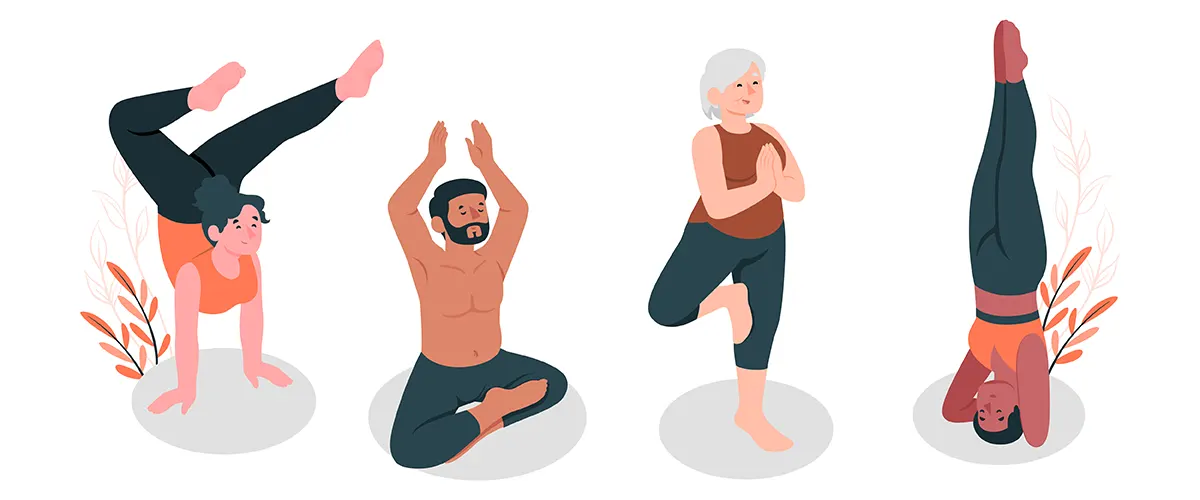You’re a student in college. You have tests to study for, preparing for a job (or two! ), which consumes a lot of your time. On top of that, being social, and taking out time to spend with friends and family is also important. At times, all the life hustles take over your mental health as a student.
This is where the benefits of yoga for students chime in. Many students find that practicing yoga helps them balance the tensions that come with their busy schedules.
While being a student is thrilling and memorable, it is also not always a bed of roses. Exams, career decisions, and peer pressure can be detrimental to a student’s mental health. Stress levels in college students increase because they worry about interviews and selecting the right job description. A student is frequently torn between fitting in with his peers and succeeding. Stress is one of the many difficulties that college students encounter. To curb the increasing level of stress, the benefits of yoga for students are highlighted by experts.

Yoga Aligns your Life- Physically & Mentally
In addition to being fascinating and enjoyable, school or university can also be difficult. You might become anxious due to entering a new university, tests, academic deadlines, moving in with roommates you don’t get along with, or even just worrying about the future. One of the reasons why there is a more and more conscious focus on the benefits of yoga for students is because of the regular fast pace of life.
Student life is one of the most memorable and influential phases of life. This period contains several pivotal moments that you as a student will cherish looking back. It may be possible that presently the phase looks stressful which is why it is important to realize the importance of yoga in your life.
As a student, you may wait for your student life to be over because of the challenges and the obstacles plus the expectations of parents. It is easy to lose mental balance and that is why the benefits of yoga for students are mainly focused on mental health further in this blog.
As a student, the other side of the fence is almost always greener for you. You may feel that another student’s life is sorted and is all colourful but that isn’t really the case.
Have we not all been in that situation? This is the reason why the benefits of yoga for students are similar to the benefits for adults as well.
Elders may find it difficult to empathize with a student. They can hardly imagine that there might be any drawbacks at all, but that only means that we are forgetting our own school days!
If memory serves us well, being a student wasn’t always a bed of roses.
Issues that students encounter on a daily basis include:
Examination stress, comparisons, memorizing a lot of chapters, feeling confident barring the socio-economic background, and bullying in unfortunate situations! Everyone has their struggles and is looking for a practice to make them feel relaxed. Within a few days of practicing yoga, you will realize the importance of yoga.
What is Yoga?
Ancient India is where yoga, a physical, mental, and spiritual exercise, first appeared. The technique was actually passed down from teacher to student long before this literature was created, with the first codification coming from the guru Patanjali in his Yoga Sutras around 400 C.E. This transmission used to be done one-on-one, but as yoga gained popularity in the West in the 20th century, group classes too over globally.

Yoga has been passed down several generations
While there have been many diverse interpretations and methods of yoga over the years, most practitioners seem to agree that the ultimate aim of the practice is to be liberated from pain. While each yoga school or tradition has its unique emphasis and practices, most yoga schools and traditions centre on integrating body, mind, and breath as a way to change energy or shift consciousness.
As a student in a school where yoga is part of your timetable, you may have heard the word, ‘asana’. Asana, a series of postures frequently combined in yoga forms like Vinyasa Flow or Ashtanga, is the aspect of modern yoga that is most frequently connected with physical practice. The main goals of asana practice are to enhance flexibility, balance, coordination, and strength while also relaxing the body. This only offers a little portion of the yoga tradition as a whole, though. Including different Asana in yoga provides a majority of benefits of yoga for students.

As a student, you might feel lost at times
Thanks to the courtesy of modernization in terms of tech, vehicles, and fast food, students suffer from a number of ailments. Diabetes, blood pressure and thyroid are not just affecting adults but are commonly reported among students as well. Students are advised to be a bit averse to allopathy and try natural remedies more. The benefits of yoga for students highlight the solutions to innumerable diseases.
Numerous physical and mental disorders are treated with yoga, and recent mind-body studies have shown that it is useful in treating conditions including diabetes, heart disease, anxiety, and depression, to name just a few.
35 Health Benefits of Yoga in 2024
1. Increases Flexibility
How Yoga helps students is that it increases flexibility. One of the first and most noticeable advantages of yoga is increased flexibility. You probably won’t be able to touch your toes or perform a backbend in your first class. But if you persevere, you’ll feel a gradual relaxation, and soon, poses that were insurmountable will become feasible. You’ll probably also start to notice that your symptoms and aches start to subside. That is not an accident.
Due to the incorrect thigh and shinbone alignment, tight hips might strain the knee joint. Back pain can result from a flattening of the lumbar spine, which can be caused by tight hamstrings. Additionally, stiffness in the muscles and connective tissues, such as the ligaments and fascia, can lead to bad posture.
2. Increases Muscular Strength
More than just looking attractive, muscles are useful. Additionally, they shield us from ailments like back discomfort and arthritis and assist in keeping older individuals from falling. And you combine strength with flexibility when you practice yoga.
If you only went to the gym to lift weights, you might lose flexibility while gaining strength. One of the benefits of yoga for students is that it improves their muscular strength.
3. Improves your Posture
Your skull is large, rounded, and weighty like a bowling ball. Your neck and back muscles will have to exert far less effort to maintain it when it is balanced directly over an upright spine. But as soon as you move it a few inches forward, those muscles start to feel strained. It’s understandable why you’re exhausted if you spend eight or twelve hours a day holding up that forward-leaning bowling ball.
Additionally, your issue might not just be weariness. Back, neck, and other muscle and joint issues can result from poor posture. Your body may flatten the natural inward curvature in your neck and lower back as a means of balancing out your droop. Spinal degenerative arthritis and discomfort may result from this.
4. Prevents the Breakdown of Joints and Cartilage
You put your joints through their complete range of motion each time you practice yoga. By “Squeezing and soaking” sections of cartilage that aren’t often used, this can help prevent degenerative arthritis or lessen handicap. Similar to a sponge, joint cartilage only obtains new nutrients when its fluid is squeezed out and a new supply can be absorbed. Neglected cartilage might gradually deteriorate without proper care, revealing the underlying bone like worn-out brake pads.
5. Protecting your Spine
The shock-absorbing spinal discs, which can herniate and pressure nerves, want motion. They can only obtain their nourishment in that way. Building up a strong back is one of the benefits of yoga for students as it enables them to try different sports activities. Your disc will stay flexible if you have a well-rounded asana practice that includes several backbends, forward bends, and twists. Yoga is known for its long-term flexibility, but this advantage is still particularly important for spinal health.
6. Increases Bone Health
Weight-bearing exercise is well known to strengthen bones and fend off osteoporosis. Yoga poses frequently call for you to lift your own weight. Asanas that strengthen the arm bones, which are particularly prone to osteoporotic fractures, include Adho Mukha Svanasana (Downward-Facing Dog) and Urdhva Mukha Svanasana (Upward-Facing Dog).
7. Stimulates the Flow of Blood
Yoga increases blood flow. Particularly in your hands and feet, the relaxation techniques you acquire during yoga can improve your circulation. Your cells perform better as a result of yoga because it increases oxygenation in your body. Twisting positions are supposed to squeeze venous blood out of internal organs and, once the twist is relaxed, allow oxygenated blood to flow in.
8. Raises Immunity and Lymphatic Drainage
Increased lymphatic drainage occurs as you tense and stretch muscles, move organs, and enter and exit yoga poses (a viscous fluid rich in immune cells). This supports the lymphatic system’s ability to combat infections, eliminate malignant cells, and get rid of harmful byproducts of cellular activity.
9. Elevates the Heart Rate
You reduce your risk of heart attack and also lessen depression when you frequently raise your heart rate into the aerobic range. How yoga helps students is that it elevates the heart rate and reduces the risk of heat-related illnesses.
While not all yoga is aerobic, it can raise your heart rate into the aerobic range if you practice it vigorously or take flow or Ashtanga sessions. However, even yoga poses that don’t raise your heart rate as much will strengthen your cardiovascular system. Yoga practice has been shown to boost maximum oxygen uptake during exercise, increase endurance, and lower resting heart rate—all indicators of increased aerobic conditioning.
10. Lowers Blood Pressure
Yoga may be helpful if you have high blood pressure. Two studies on persons with hypertension compared the effects of Savasana (Corpse Pose) with merely lying on a couch and were published in the British medical magazine The Lancet.
11. Controls the Adrenal Glands
Cortisol levels are reduced by yoga. If you think that’s not much, take this into account. In reaction to a severe emergency, the adrenal glands normally release cortisol, which momentarily strengthens the immune system. Even when the crisis has passed, excessive cortisol levels might impair the immune system. Temporary increases in cortisol are beneficial for long-term memory, but persistently high levels impair memory and may cause long-lasting brain alterations.
12. You get Happier
Are you sad? Sit Lotus-style. Better yet, take a backbend or ascend to King Dancer Pose with majesty. While it’s not quite that straightforward, one study revealed that regular yoga practice reduced cortisol and monoamine oxidase levels, which are responsible for the breakdown of neurotransmitters and alleviated depression.

Yoga brings out positivity toward life
13. Discovers a Healthy Way of Living
One of the substantial benefits of yoga for students is transitioning into a healthy way of living. Many dieters subscribe to the maxim “Move more, eat less.” Both can benefit from yoga. The spiritual and emotional aspects of your practice may inspire you to address any food and weight issues on a deeper level. A regular practice gets you moving and burns calories. You might be motivated to eat more mindfully by your yoga practice. Yoga’s resonant effects on other facets of your life are one of its advantages.
14. Lowers Sugar Levels
Yoga increases the “good” cholesterol while lowering blood sugar and “bad” cholesterol. Yoga has been shown to lower blood sugar in diabetics in a number of ways, including by lowering cortisol and adrenaline levels, promoting weight reduction, and increasing sensitivity to the effects of insulin.
The benefits of yoga for students involve losing weight and losing sugar levels as well! You can lessen your risk of developing diabetic complications like heart attack, renal failure, and blindness by lowering your blood sugar levels.
15. Aids Concentration
Yoga stresses the importance of being in the now. Regular yoga practice enhances coordination, response time, memory, and even IQ scores. Transcendental Meditation practitioners have been shown to be better at problem-solving, learning, and remembering information—possibly because they are less preoccupied with their thoughts, which can repeat endlessly like an unending tape loop.
16. Soothes your Body
Yoga promotes relaxation, slower breathing, and present-moment awareness, which helps balance the sympathetic nervous system (also known as the “fight-or-flight reaction”) and the parasympathetic nervous system.
17. Increases Balance
Regular yoga practice enhances proprioception (the capacity to feel where your body is in space and what it is doing) and balance. Proprioception is typically impaired in people with poor posture or dysfunctional movement patterns, which has been associated with knee and back discomfort. The benefits of yoga for students are increasing balance both mentally and physically.
18. Keeps your Neurological System Healthy
Some highly skilled yogis have incredible control over their bodies, most of which is mediated by the neurological system. Yoga practitioners who might cause odd heart rhythms and produce particular brain wave patterns have been seen by scientists.
19. Enables you to Relax your Limbs
Do you ever catch yourself using a death grip on the phone or a steering wheel, or tensing up your face while looking at a computer screen? These unintentional behaviors can cause chronic tension, muscle pain, and exhaustion in the wrists, arms, shoulders, neck, and face, which can affect your mood and raise stress. You start to become aware of your tension-holding patterns when you practice yoga: Your tongue, eyes, or facial and neck muscles could all be affected.
20. Relaxing Sleep
Studies indicate that improved sleep is a side effect of frequent yoga practice, which means you’ll be less exhausted, worried, and prone to mishaps. One of the main advantages of yoga, regardless of one’s skill level, is the ability to sleep better.

Relaxed Mind, Relaxed Sleep
21. Boosts the Effectiveness of your Immune System
The immune system is likely to benefit from asana and pranayama, but so far, meditation has the most robust scientific backing. It seems to have a positive impact on the immune system’s functionality, boosting it when necessary (for instance, by elevating antibody levels in response to vaccination) and reducing it when necessary.
Yoga for Healthy Lungs has been demonstrated to enhance a number of lung function tests, including the ability to breathe deeply and effectively exhale.
Yoga also encourages nose breathing, which purifies the air, warms it (cold, dry air is more likely to cause an asthma attack in people who are susceptible to it), and humidifies it, removing pollen and other contaminants you’d rather not breathe into your lungs.
22. Provides you with Comfort
The Yoga Sutras of Patanjali state that yoga calms mental fluctuations. In other words, it lessens the stress-causing mental loops of frustration, regret, wrath, fear, and want. And because stress is linked to a wide range of health issues, including migraines, insomnia, lupus, eczema, high blood pressure, and heart attacks, if you learn to calm your mind, you’ll probably live longer and be in better condition.
23. Boosts your Confidence
Many of us have persistent poor self-esteem. If you react negatively—use drugs, overindulge, put in excessive hours at work, or party too much—you can pay a price in terms of worsened physical, mental, and spiritual health. If you adopt a good outlook and practice yoga, you’ll sense that you’re valuable or, as yogic philosophy teaches, that you are a manifestation of the Divine, initially in fleeting glimpses and subsequently in more prolonged perspectives.

Transform into a Confident person with Yoga
24. Eases your Suffering
Yoga can help you feel better. Numerous studies have shown that asana, meditation, or a combination of the two can lessen pain in persons with chronic diseases like fibromyalgia, carpal tunnel syndrome, arthritis, and back pain. You feel better, are more likely to be active, and use less medication when your pain is reduced.
25. Provides Inner Strength
You can change your life with the aid of yoga. That very fact may be its greatest asset. The word tapas, “heat” in Sanskrit, refers to the discipline and fire that regularly practiced yoga builds. To overcome lethargy and break bad habits, you can use the techniques you learn for the rest of your life.
26. Connects you with Guidance
Your health can benefit greatly from a good yoga teacher. The best ones go beyond merely directing you through the poses. The benefits of yoga for students are that it can connect you with your health and keep it in alignment.
They can help you relax, correct your posture, judge whether you should hold postures longer or shorten them, give harsh truths with compassion, and otherwise improve and customize your practice. Your health is greatly benefited by having a cordial relationship with your teachers.
27. Awareness for Transformation
Meditation and yoga increase awareness. Additionally, letting go of negative emotions like rage becomes easier the more conscious you are. According to studies, persistent resentment and rage are just as strongly associated with heart attacks as smoking, diabetes, and high cholesterol.
By fostering sentiments of compassion and connectedness, as well as by soothing the nervous system and the mind, yoga appears to lessen anger. Additionally, it improves your capacity to step back from the turmoil in your own life and maintain composure in the face of distressing developments.
ALSO READ: Top 20 Benefits Of Meditation For Students
28. Helps you to help others
The yogic concept is inseparable from karma yoga (doing good for others). And even if you might not have a strong desire to help others, doing so might be good for your health. That older persons who gave a little under an hour each week had a threefold increased chance of living seven years later.
Serving others can give your life purpose and make your troubles appear less severe when you consider what other people are going through.
29. Get Rid of Stress
Because college students are under a lot of stress from day one, this is the most common reason people start taking yoga lessons. A stressful social environment, financial stressors, and pressure from family and friends to succeed all add up and have an impact. It may be beneficial to take a few minutes each day to breathe deeply in order to reduce and eliminate stress.
30. Reduces Conflict
Conflicts will inevitably occur if you live in a dorm room, fraternity house, or apartment building with other people. Yoga can assist with this by lowering tension and boosting self-assurance to help cleanse your thoughts and bring about a sense of tranquillity. Numerous students discover that practicing yoga improves their ability to manage their emotions and deal with unpleasant situations.
31. Boosts Concentration
Many people who practice yoga find it easier to focus. Yoga can assist students to escape the continual social environment of college since it helps the mind become clear. Reading, studying, and listening to lectures can all be made simpler by becoming more adept at entering a peaceful mental zone. The benefit of yoga for students in academics is that it boosts concentration. College students can readily use the breathing exercises taught in yoga to help them focus.
32. Boost your posture
Keep that fact in mind for bar trivia the following week. Indian monks created yoga to aid them in sitting through extended periods of meditation. Another method yoga can help college students is by helping them with their posture. This is because college students spend most of their days sitting in class, followed by hours of studying or working while standing up.
33. Strengthen Core
Flexibility is one of yoga’s biggest advantages because it will help you become stronger and more resilient in other physical endeavours. Yoga has several positive side effects, including strengthening the core, which can assist protect the back during all of your college years’ frequent transfers into and out of apartments and dorm rooms.
It’s possible that the type of fitness routine that works best for you won’t work for the next individual. An excellent method to decide which type you should incorporate into your daily routine is to try out several different kinds.
34. Enhanced Body Posture
Long periods of time spent curled up on one spot reduce breathing capacity and cause constant pain. Through yoga, you can gradually become more aware of your body and develop precise muscle adjustment.
The body can function with a negligible amount of vitality when it is adjusted effectively. Yoga postures were designed to empower high stance while promoting equality, adaptability, and stamina.
Through the practice of yoga, one can develop a new, more positive outlook, increased energy, and the ability to focus on what is necessary while pushing aside distracting thoughts.
35. Increased Sharpness, Improved Concentration, and a Longer Attention Span
Children with a lot of energy may find it difficult to concentrate on their studies. Children have been shown to be able to focus longer on subjects with consistent yoga practices lasting 20 minutes each day for roughly a month.
The yogic condition and norms encourage the mind to narrow its focus and pay careful attention to one topic while putting aside distractions.
Your mental acuity and capacity for focus both improve with yoga. It aids in mental relaxation and offers mental tranquillity.

Yoga has the power to transform your life
The benefits of yoga for students are innumerable and they can transform your life and mental stability. Yoga education is now a staple in schools and institutions’ curricula. People around the globe understand the importance of yoga and so do the students.
ALSO READ:

